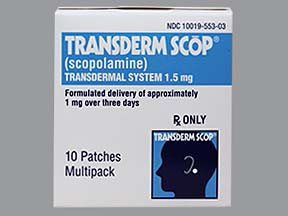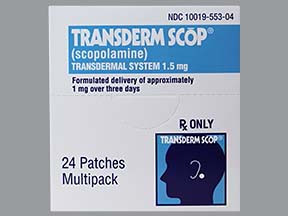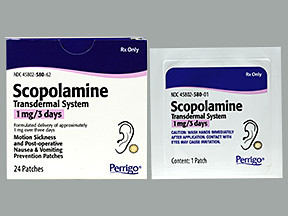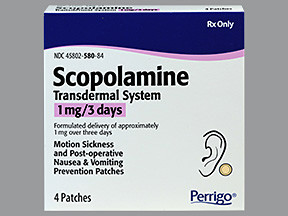SCOPOLAMINE - TRANSDERMAL
PHONETIC PRONUNCIATION: (skoe-POL-a-meen)
COMMON BRAND NAME(S): Transderm-Scop
GENERIC NAME(S): scopolamine
Uses
USES: This skin patch is used to prevent nausea and vomiting caused by motion sickness or recovery from anesthesia and surgery. This medication works by correcting the imbalance of natural substances (acetylcholine and norepinephrine) that can occur in motion sickness. It also blocks certain signals to the brain that can cause nausea and vomiting. This medication is not recommended for use in children.
How to use SCOPOLAMINE - TRANSDERMAL
HOW TO USE: Peel off the clear backing from the patch and apply it to a clean, dry, hairless area of the skin behind the ear. Press firmly for at least 30 seconds to make sure the patch sticks well, especially around the edges. The patch will slowly release the medication into your body over 3 days. Do not use the patch if it is broken, cut, or damaged. If you are using the patch to prevent nausea and vomiting from motion sickness, apply the patch as directed by your doctor, usually at least 4 hours before the activity that causes motion sickness. Replace the patch every 3 days until it is no longer needed. If you are using the patch to prevent nausea and vomiting after surgery, apply the patch as directed by your doctor, usually the evening before surgery. If the surgery is for a cesarean section, then the patch is usually applied 1 hour before the procedure to reduce the baby's exposure to the drug. Remove and throw away the patch as directed by your doctor, usually 24 hours after surgery. If the patch comes off or needs to be replaced, throw away the old patch and place a new one behind the other ear, on a clean, dry, hairless area. Use only one patch at a time. When throwing away the old patch, fold it in half with the sticky side together and throw away in the trash away from children and pets. This medication can cause temporary blurred vision and widened pupils if it comes in contact with the eyes. Therefore, after handling the patch, always wash your hands thoroughly with soap and water. Also wash the area behind the ear where the patch was removed. After stopping this medication, you may experience dizziness, loss of balance, nausea/vomiting, headache, muscle weakness, or slow heartbeat. If these effects occur, they usually appear 24 hours or more after you stop this medication. This is a result of your body adjusting to being off the medication. Report any such reactions to your doctor right away. Tell your doctor if your condition persists or worsens.
Side Effects
Precautions
Interactions
Overdose
Images
Reviews
Faq for SCOPOLAMINE - TRANSDERMAL
Scopolamine transdermal is a medication patch that contains the active ingredient Scopolamine. It is used to prevent nausea and vomiting caused by motion sickness or certain medical procedures.
Scopolamine transdermal works by blocking certain receptors in the brain that are responsible for triggering nausea and vomiting. It helps to prevent these symptoms by reducing the signals sent to the vomiting center in the brain.
Scopolamine transdermal patches should be applied to a clean, dry, and hairless area behind the ear, at least 4 hours before the desired effect. It is usually worn for up to 3 days. Follow the instructions provided by your healthcare provider for proper usage.
Common side effects of Scopolamine transdermal include dry mouth, drowsiness, dizziness, blurred vision, and disorientation. These side effects are usually mild and may improve with time.
Scopolamine transdermal may interact with other medications, including antihistamines, sedatives, and certain antidepressants. It is important to inform your healthcare provider about all the medications you are taking to avoid any potential interactions.
It is generally recommended to avoid exposing the Scopolamine transdermal patch to water as it may decrease its effectiveness. However, some patches may be specifically designed to be worn during activities such as swimming or showering. Follow the instructions provided with your specific patch.
Scopolamine transdermal should only be used during pregnancy or breastfeeding if the potential benefits outweigh the potential risks. It is important to discuss the risks and benefits with your healthcare provider before using this medication.
Scopolamine transdermal usually takes about 4 hours to start working after the patch is applied. It is important to apply the patch at least 4 hours before the desired effect, such as before traveling or undergoing a medical procedure.
Scopolamine transdermal patches should not be cut or trimmed as it can affect the dose and release rate of the medication. Follow the instructions provided by your healthcare provider on how to use the patch correctly.
Disclaimer
IMPORTANT: HOW TO USE THIS INFORMATION: This is a summary and does NOT have all possible information about this product. This information does not assure that this product is safe, effective, or appropriate for you. This information is not individual medical advice and does not substitute for the advice of your health care professional. Always ask your health care professional for complete information about this product and your specific health needs.






No Reviews Yet